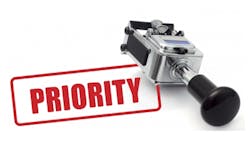Today, it dawned on me why so many leaders tell you that safety isn’t – or shouldn’t be – a priority (because priorities change). Safety is – or should be – a core value, deeply embedded into a firm’s operating principles and strategies.
Of course, that makes perfect sense. But it really hit home for me this morning when I read this headline on the website of the Twin Falls, Idaho, Times-News: “Safety a Priority After Wendell City Worker Death.”
Here’s the gist of the story:
The city of Wendell has quietly improved safety procedures, while family, friends and co-workers have slowly tried to heal after the September death of city employee Jerrad Durfee.
Durfee, 43, a Wendell public works employee, was killed Sept. 10 when the trench he was working on while installing stormwater lines collapsed, burying him in a foot of loose dirt. Since the accident, the city is contracting out large projects and pushing safety awareness.
I’m not trying to pick on the Times-News or the writer here. The headline seems perfectly fine to me. And the article summarizes the events of the story quite nicely. But if I could hack into the newspaper’s website, I’d probably italicize the word “After” in the headline.
As someone who covers and is involved in the EHS community, I can’t help but roll my eyes when I see a headline like that. Again, it has nothing to do with the quality of the headline. I roll my eyes, almost involuntarily, because I’m a true believer in the power and importance of workplace safety. So when I roll my eyes at a headline like that, I’m thinking to myself, “Well, duh. Of course safety is a priority after someone died.”
I’ve said it before, and feel free to confirm it or deny it: Nothing gets a company (or city, in this case) more fired up about safety than a bad accident. Nothing gets the attention of the CEO and the board of directors like a factory blowing up. Nothing puts safety on a small-business owner’s radar as quickly as a fatality (or an OSHA inspection). No one is more passionate about safety than a guy who just watched his best friend and co-worker die on the job.
In this case, the city of Wendell, Idaho, as Alison Gene Smith reports, is redoubling its safety efforts after losing an employee in a trench collapse. “Well, of course it is,” says my cynical side. Again, the headline: “Safety a Priority After Wendell City Worker Death.” I don’t mean to pick on the city of Wendell, Idaho, either. Although there are many organizations that truly are proactive – and we recognize them every year through our America’s Safest Companies program – I’m guessing there are just as many that could be plugged into the headline and substituted for “Wendell City.” It happens everywhere.
In my mind, that’s why EHS leaders at top-performing organizations eschew viewing safety as a priority. Like the flavors of the month, priorities change, in response to shifts in market sentiment, regulatory activity and other factors. But core values are more apt to stand the test of time.
Of course, some priorities (such as making money ) tend to have more staying power than others. But when safety is a priority, it seems to be more vulnerable than other programs to falling by the wayside when times get tough. I’m not saying that’s what happened in Wendell, Idaho; I’m speaking in generalities here.
Too many organizations fall into the “After” trap – they focus on safety after a bad accident. Obviously, that’s too late.
About the Author
Josh Cable Blogger
Senior Editor
Josh Cable is senior editor of EHS Today, a Penton publication. In his nearly 15 years as a journalist, he has covered a wide range of topics, including banking and finance, occupational safety and health, government purchasing and U.S. manufacturing. As a former editorial-staff member of Penton’s IndustryWeek and Occupational Hazards, he has toured dozens of manufacturing facilities, establishing himself as a subject-matter expert in world-class production, quality and safety systems.
